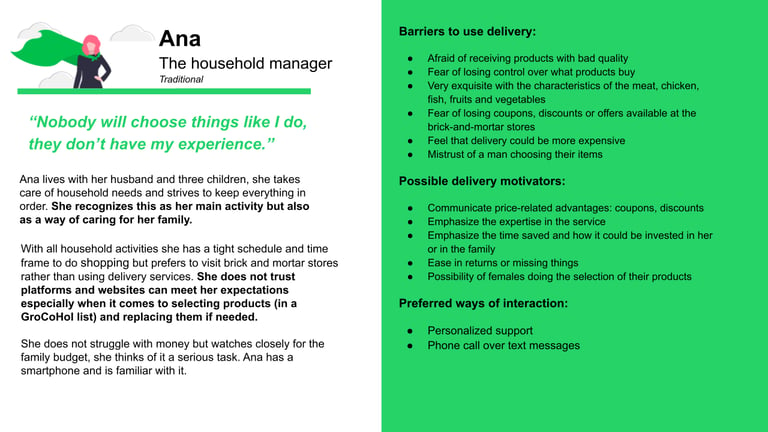Why do major delivery
apps fail in Brazil?
Research objectives
Understand the reasons that lead people to choose to shop for groceries, convenience items, and alcoholic beverages through apps.
Identify which apps are most used for this purpose and the reasons behind consumers’ choices.
Understand the most valued benefits in each app, from the users’ point of view.
Also analyze the behavior of people who prefer to shop in person, understanding their barriers to digital.
My role in the research
I worked as a researcher on the Brazilian team, focusing on:
Attending 60-minute individual qualitative interviews, exploring shopping behavior, motivations, customer journey, and post-purchase experiences.
Monitoring 3-day diaries to observe real app usage, comparing the client’s app with competitors.
Creating mind maps to identify consumer profiles.
Developing personas in collaboration with teams from other countries.
Structuring debrief and insights boards to facilitate analysis and communication of results.
Context
After ending restaurant delivery operations in Brazil and keeping only the grocery delivery service, the company needed to deeply understand consumer behavior in this new scenario. The goal was to identify opportunities and avoid repeating past strategic mistakes, considering the particularities of the Brazilian, Chilean, and Mexican markets. The research was conducted collaboratively and simultaneously in all three countries, with integrated deliverables and daily alignment among the teams.
Methodology and execution
We received the interview guidelines from the team in Mexico, which we adapted for the Brazilian context by translating and adjusting the script and screener. While participants were being recruited, I created note-taking templates and dashboards to organize the information.
In the individual qualitative interviews, we mapped out the customer journey based on their most recent order, understanding everything from the decision-making moment to post-sales support. We also interviewed people who don’t shop online to capture their barriers and preferences.
In the second phase, the diaries allowed us to observe nuances of real usage, highlighting both positive and negative aspects of the client’s app and those of competitors.
Insights and findings
The qualitative analysis revealed three clear consumer profiles, defined in the mind maps:
The traditional customer: Prefers to shop in physical stores to save money and because they consider the process faster than delivery.
The digital enthusiast: Buys everything online, values convenience, and often recommends apps to their social circle.
The intermittent shopper: Looks for promotions both in physical stores and online, buying wherever they find the best deal at the moment.
These profiles were essential for creating six personas, representing consumers from the three countries, with two cross-cutting profiles that unified common characteristics.
Value proposition and strategic direction
With these insights, we developed a value proposition specifically for the Brazilian market, reflecting the real needs and motivations of local users. In a collaborative workshop, we defined the North Star that would guide the three researched markets, aligning vision and strategy.
Impact
The research revealed that the main reason the previous app was not successful in Brazil was the limited payment options. This provided a solid basis for leadership to decide against investing in a new attempt in the country, since they understood it would not be worthwhile to invest in adding more payment methods.
Instead, the company chose a strategic partnership with an already established local player, integrating the shopping service with the mobility service, which increased the chances of success and consumer adoption.
*The company information has been withheld to ensure the protection of confidential data.
Interviews
Each individual interview lasted about 60 minutes and included a detailed reconstruction of the most recent purchase journey: from the decision-making moment, through the choice of app, to post-sales support.
Diaries studies
In the second phase, participants kept diaries for three days, recording their experiences when buying both on our client’s partner app and on their usual app. This made it possible to compare perceptions, identify positive and negative points, and map out opportunities for differentiation.
Results


Research objectives
Understand the reasons that lead people to choose to shop for groceries, convenience items, and alcoholic beverages through apps.
Identify which apps are most used for this purpose and the reasons behind consumers’ choices.
Understand the most valued benefits in each app, from the users’ point of view.
Also analyze the behavior of people who prefer to shop in person, understanding their barriers to digital.
My role in the research
I worked as a researcher on the Brazilian team, focusing on:
Attending 60-minute individual qualitative interviews, exploring shopping behavior, motivations, customer journey, and post-purchase experiences.
Monitoring 3-day diaries to observe real app usage, comparing the client’s app with competitors.
Creating mind maps to identify consumer profiles.
Developing personas in collaboration with teams from other countries.
Structuring debrief and insights boards to facilitate analysis and communication of results.
Context
After ending restaurant delivery operations in Brazil and keeping only the grocery delivery service, the company needed to deeply understand consumer behavior in this new scenario. The goal was to identify opportunities and avoid repeating past strategic mistakes, considering the particularities of the Brazilian, Chilean, and Mexican markets. The research was conducted collaboratively and simultaneously in all three countries, with integrated deliverables and daily alignment among the teams.
Methodology and execution
We received the interview guidelines from the team in Mexico, which we adapted for the Brazilian context by translating and adjusting the script and screener. While participants were being recruited, I created note-taking templates and dashboards to organize the information.
In the individual qualitative interviews, we mapped out the customer journey based on their most recent order, understanding everything from the decision-making moment to post-sales support. We also interviewed people who don’t shop online to capture their barriers and preferences.
In the second phase, the diaries allowed us to observe nuances of real usage, highlighting both positive and negative aspects of the client’s app and those of competitors.
Insights and findings
The qualitative analysis revealed three clear consumer profiles, defined in the mind maps:
The traditional customer: Prefers to shop in physical stores to save money and because they consider the process faster than delivery.
The digital enthusiast: Buys everything online, values convenience, and often recommends apps to their social circle.
The intermittent shopper: Looks for promotions both in physical stores and online, buying wherever they find the best deal at the moment.
These profiles were essential for creating six personas, representing consumers from the three countries, with two cross-cutting profiles that unified common characteristics.
Value proposition and strategic direction
With these insights, we developed a value proposition specifically for the Brazilian market, reflecting the real needs and motivations of local users. In a collaborative workshop, we defined the North Star that would guide the three researched markets, aligning vision and strategy.
Impact
The research revealed that the main reason the previous app was not successful in Brazil was the limited payment options. This provided a solid basis for leadership to decide against investing in a new attempt in the country, since they understood it would not be worthwhile to invest in adding more payment methods.
Instead, the company chose a strategic partnership with an already established local player, integrating the shopping service with the mobility service, which increased the chances of success and consumer adoption.
*The company information has been withheld to ensure the protection of confidential data.
Interviews
Each individual interview lasted about 60 minutes and included a detailed reconstruction of the most recent purchase journey: from the decision-making moment, through the choice of app, to post-sales support.
Diaries studies
In the second phase, participants kept diaries for three days, recording their experiences when buying both on our client’s partner app and on their usual app. This made it possible to compare perceptions, identify positive and negative points, and map out opportunities for differentiation.
Results


